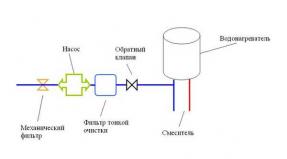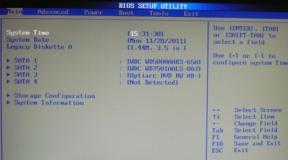How to determine the symptoms of retinal detachment of the eye and not miss the first signs of the disease? What should not be done when detaching the mesh shell? Who enters the risk group
AT clinical practice, among patients with retinal detachment (OS), a group of patients with old rigid flat retinal delayes spread to two lower quadrannt of the eyeball are distinguished.
The lower flat retinal detachments with multiple minor holes in myopia, combined with PCHD, tend to slow progression and the development of local interrupted proliferative vitreoretinopathy (PVR), retina rigidity, trends towards self-denial. In this case, the functions of the organ of vision in patients are preserved while the process does not apply to the central zone. The lack of complaints makes it difficult to detect retinal detachment.
As a rule, these are patients of young age with a preserved high central and peripheral field of view, with myopia more than 3 diopters, addressed to an ophthalmologist due to a planned diagnostic examination or laser correction myopia. The retinal detachment was diagnosed after inspecting the eyebound with a three-merical goldman lens. In all patients, multiple holes are revealed against the background of the retinal lattice dystrophy in the meridians from 4 to 5 hours, the different degree of PVR (stage B-C 1-3), the propagation of the retinal detachment from the extreme periphery to the central zone. Solving the issue of tactics, character, volume of surgical intervention with the bottom flat back pairs of the retina ambiguously.
goal
Analysis of the surgical treatment of the lower flat nets of retina with multiple hole breaks, correction of indications to minimal extracaleral surgery and vitreoretinal interventions.
Materials and methods
The material served 30 operations made about the above backlamp of the retina in the FSU "MNTK" MG ". Acad. S. N. Fedorova Rosmedtehnology. " The age of patients - from 12 to 35 years. The long-standing time of the retinal detachment was more than six months.
Etiology in all patients on the background of myopia various degrees -Periferic lattice retinal dystrophy.
1st group of patients: 10 people - operated by extrasal
local sealing, in 2 cases with circulation. PVR stages in patients were a, in, with 1-3. The macular zone remained fixed.
A group of patients: 20 people - operated on endochitrial. Stage
PVR-C 1-3, in 2 cases OS, applied above the lower vascular arcade with the capture of the macular zone. In 3 cases, subretyl trenches were held through the central zone without retinal contract. In all cases, a rigid common flat retinal detachment with preset membranes was observed. There was an injecting of extreme peripheral vessels. All patients surgical intervention was carried out using the Millennium's ophthalmic surgical system - the rear closed vitrectomy is subtotal, removal of preset membranes (retina mobilization), tamponade perfluororganic compound (perfluorodicalin) - adaptation of the retina, endolanerocoagulation (retinal fixation). After 7-14 days, the perfluororganic compound (PFOS) was replaced with silicone oil.
In 5 cases, with the aim of adapting the retina, a relaxing, common up to 180 °, local (in 2-3 meridians) of retinotomy on the middle periphery of the retina in the lower quadrants was carried out.
Results and discussion
Given the good retinal visualization, a flat retinal detachment with a height of no more than 3.5 mm with a demarcation line without capturing the central zone, the patients of the 1st group managed to block the gaps in all cases, the subretal liquid was resolved between 10 days to 3 months. In 2 patients, despite full blockade breaks, retained retinal detachment from the shaft of the pressure, flat, up to 1-1.5 mm. The second stage conducted an endonovitre operation with local retinotomy, a complete retinal adaptation was achieved. In all patients of the 1st group, a macular zone was fixed to surgery. Functional results After the operation are good, the values \u200b\u200bof the indicator of the visual acuity with the correction - from 0.7 to 1.0, the field of view is complete. In the postoperative period, all (PVR-C 1-3) is a patient with transpillary laser -ugoagulation.
In the second group, in 15 cases, after the complete removal of the preset membranes, the retina was mobilized, fixed with the help of a short-term tamponade of the PFOS (7-14 days), followed by a substitute for silicone oil. In 2 cases, after the simultaneous substitution of the PFOS on silicone, the retinal dedication of the PVR was relating to the reinforced progression of the PVR, which resulted in repeated endo-propreal intervention with retinotomy, endolanerocoagulation (elk) of the retina and subsequent Tamponade PFOS and Silicone Oil.
In 3 cases during the operation, despite the complete mobilization of the retina, an anatomical fit to achieve failed on Tamponade of Vitreopress. Related retinotomy on medium peripherals with subsequent adaptation, ELK of retina and tamponade PFOS with silicone oil was performed in the lower quadrants. In all cases, silicone is removed after 1 month.
Functional results (15 cases) with a fixed macular zone are good, completely visual acuity recovered after 1-3 months. after operation. In 5 cases, a detachment of the macular zone was observed, subretenyl alley in the central zone, the values \u200b\u200bof the visual sharpness decreased by 0.1-0.2 from the source. Impact fields are restored in all patients.
findings
1. Despite the optimal conditions for the minimum extracephallectual surgery - good retinal visualization, the transparency of optical media, the low height of the lower sweeps of the retina, the possibility of full blocking of all breaks - adaptation and mobilization of the retina is difficult, which requires re-surgical endovitreal intervention. The main indicators to extracillary surgery is the PVR stages A, B, C 1-3, the lack of detachment in the macular zone.
2. Considering the rigidity of the old lower retinal detachments, the PVR-C 1-3 stage, in some cases it is necessary to produce a local touching retinotomy to fully adapt and fix the retinet, PFOS tamponad for 7-10 days, followed by a substitute for silicone.
3. It is advisable to combine the extrabulbar and endovitreal surgical intervention at the PVR-C 1-3 stage with the capture of the central zone.
It consists of visual receptors (the so-called "columns" and "sticks") and plexus of nerve fibers. Their destination is to capture light waves and recode them into a nervous impulse. This information then enters the brain. In the depths of the retina are vessels. On them, blood is in mind oxygen and feeding substances. Damage to the retina, and even more so its detachment, causes impairment of vision, up to its fullest loss.
Violations of the functions of the retina occur during hemorrhages, injuries, genetic pathologies in the structure of blood and nervous eye systems.
In the elderly, the detachment causes degenerative and dystrophic states. They are provoked by violations in the blood supply and metabolism of the eyes. The dangerous voltage of the mesh shell appears in hypertensive diseases due to increased pressure in small vessels.
The retinal detachment of the eye is one of the most common and dangerous pathological conditions. visual organs. In the development of pathology, the eye does not come in sufficient amounts of oxygen and feeding substances. This leads to dangerous violations of vision.
Pathology in most cases requires urgent surgery. Only in the easiest cases are used drug therapy.
By code MKB-10 The retinal detachment of the eye has an H33 index.
Causes of the disease
The retinal detachment can cause different reasons. The diagnostic equipment and a qualified ophthalmologist helps to determine them. When diagnosing the disease, all the pathological conditions of the body systems, which can lead to violations of violations are taken into account.
Often the reason for the retinal detachment is injured by eye shells with their rupture. This pathology also causes unsuccessful or late therapy of such diseases negatively acting on visual bodies:
- Diabetes - defeat blood vessels retina;
- Inflammatory processes in blood and nervous system eye;
- Tumors of the organs of vision;
- Diseases of the center of the Eye DNA.
Sometimes it seems healthy man Suddenly there is a peripheral vitreochorioretinal dystrophy. She entails a sharp loss of visual acuteness. This pathological condition is difficult to determine. Because of this, an ophthalmologist may not immediately diagnose the cause of impairment of vision. With such a situation, it is necessary to use a three-member lens of Goldman. It helps carefully inspect the eye bottom.
Factors in which the risk of retinal detachment is especially large:
- injury to organs of vision;
- disorders that attract pathological changes in the eye day;
- adverse working conditions under which the organs of view acts too low or high temperature, various irritating agents, etc.;
- sports, especially various species martial arts;
- hereditary predisposition.
Classification of pathology
For reasons that caused a detachment, it may be:
Traumatic detachment. Here the retina moves due to the impact on the whole eye. This can happen immediately after what happened either after some time interval.
Training retinal retinal detachment. In this case, the tissue is moving out due to its tensioning with a vitreous body. It can swell, have an incorrect configuration or eneem.
Remotogenic retinal detachment (primary). It appears due to the dystrophic state of the tissue, due to their long-lasting vascular failure. It provokes thinning the mesh shell and breaking it. In this case, the vitreous fluid penetrates the retina, it stops her nutrition and disrupts the functioning.
Exudative retinal detachment (secondary). Appears in the form of complications when infected with eyes (, panofalmite, etc.), neoplasms of the mesh shell, its blood vessels. At the same time, swelling (liquid accumulation) occurs in the deep tissues of the eye).
By level of mobility tissue, the detachment may be:
- rigid - the retina does not return to the place (not adjacent to the eye DNU) under bed mode for two days;
- movable - when finding a patient in bed for two days, the retina completely conjugates with the deep layers of the eye.
- Local - peeling a quarter of the retina.
- Common - leaves half of the fabrics.
- Subtotal - a mesh shell is broken from the eye bottom.
- Total - the entire retina area hovers.
Symptoms of retinal peel
The first symptom of peeling the retina is photopsy. They are sparing in the eyes of sparkers, lightning, bright dots, etc. Photopsy arise due to the fact that impulses are formed in visual receptors, both when the light rays penetrate them and during the mechanical impacts on the retina. A vitrehetinal splicing stretches fabrics, affecting sensitive cells. This provokes photos.
The retinal detachment is often accompanied by slowly floating in front of the threads, dots and flies. But such photopsy is not direct signs of pathology, they often appear and do not require therapy. As a rule, they provoke them.
Often in the field of view of the patient arises ring Weissa (Round Tamble). It indicates the retinal detachment, as well as the rear separation of the vitreous body (its hyaloid membrane) from the point of fixation to the disk of the optic nerve.
In the field of view of the patient, darkened moving stains or a web can occur. These phenomena provoke bleeding in a vitreous body when taking the mesh shell.
Sometimes the patient falls out the sections of the visual field. At the same time, the eye covers either a paddle. This process provokes a retractable tissue tissue. Because of this, the visual perception of the patient is frustrated.
The photo shows the human eye when detaching the retina of the eye.
It is worth noting that the peeling occurs in the place of the shell, which is opposite to the emergence. When the defective area of \u200b\u200bview is manifested at the top, it means that there has been a waste of the bottom of the retina and vice versa. This symptom can weaken or disappear in the morning and manifest with a new power in the evening. This is due to the suction of the subretinal substance. When the process develops on sites in the middle of the eye, the described symptom will not appear.
The upper sections of the mesh shell are faster than the lower. This is due to the fact that the liquid accumulated in the intercellular space slowly flows down. It takes off the lower parts of the retina. This process can leak without any manifestations. He makes himself felt only when the macular zone is defeated.
The patient may also occur such symptoms: a drop in visual acuity, distorted configuration perception and dimensions. Metamorphic can also be observed (straight lines are perceived by curved). The strength of this effect is dependent on the level of pathological changes in various sections of the mesh shell.
These features may occur at:
- injury to organs of vision or head;
- deliverance from either an extraneous subject;
- intravial injections;
- vitrectomy;
- sealing sclera;
- laser coagulation.
Therefore, when patient with metamorphic photocons appears, the doctor must carefully examine him for collecting information and diagnosis.
All of the above signs of retinal detachment of the eye are most often manifested in the early duration of the disease. The symptoms of the secondary type of pathology are few, due to the fact that the exudative separation is not tied to tension tension.
Traction separation takes place most often flows slowly and without special signs. Photopsy and other violations of vision grow gradually either do not develop at all. Sometimes for several years. Only if pathology begins to touch on the macul, the patient will notice a significant drop in visual acuity.
Diagnostation
If there is a suspicion of the handless of the mesh shell, the patient should pass a full course of diagnostic surveys. Only early detection of pathology makes it possible to stop partial or complete. If the patient's history has a crank-brain injury, a neurologist should be inspecting, and then an ophthalmologist. The latter must make sure that the patient did not have detachments and discontinuities of the mesh shell.
First, the ophthalmologist checks the patient with visual visual and identifies the defects of visual fields. This is done with the help of kinetic, static, computer.
(Most often a Lens Goldman is used) makes it possible to examine the periphery of the eye bottom. She reveals pathology in a vitreous body: bleeding, heavy, destructive changes.
The main role in determining the details and disruptions of the mesh shell plays straight and indirect. Its results enable doctors to judge the location of damage. And also identify the interaction of the departed tissue with a vitreous structure. The diagnostic method also allows you to determine the dystrophic places that should be taken into account during operating therapy.
If you can not (for example, a vitreous structure is littered), an eye is carried out. 
In the diagnosis of the penetration of the mesh shell, there are also surveys of entopic manifestations: autoophthalmoscopy, mechanophosphen, etc.
To find out the level of viability of tissues and eye nerves Electrophysiological procedures are carried out: the limit of electrical sensitivity and lability of systems is detected. Also determined the critical threshold of frequency of fusion of photopsy.
Treatment Single Path
The peeling of the retina is a pathology requiring immediate treatment. With prolonged flow of detachment, resistant hypotension and subatrophia appear (dieting tissue) of the eye appear chronic form And even the complete, which is impossible to cure.
The main thing is that it is necessary to do when treating the retinal detachment of the eye - closer to each other layers of fabric. If there are retinal breaks, they are blocked using surgical intervention.
Selection of a method for treating or combining methods depends on:
- Stages on which the pathological process is located;
- Location of the detached site;
- Contraindications to the operation of a specific patient.
There are two types of surgical therapy for retinal detachment. The first is the operations produced on the outer surface of the eye (extraskler). The second - manipulation carried out inside the eye (endonovitreal).
Most modern method restoration of the normal retinal state is vitrectomy. It is produced when traction tapping fabric. This is done with an endositarial way. The operation lies in the temporary removal of the vitreous substance and downloading the gas-based gas or silicone-based oil into the freed location. This composition presses disconnected layers. Thus, it provides normal retinal adjacent.
In the implementation of the endonovitre operation from the eye cavity, access to the vitreous structure and retina is carried out with the help of three dissection of cleler tissue. In this case, the size of the cuts do not exceed 1 millimeter. Through the dissection into the cavity, a miniature lighting device, tools and saline supporting the tone of the eye are introduced into the cavity. 
First of all, it is carried out with the evacuation of the vitreous structure. In order to smooth out and pressing the retinal tissue to the corresponding layers of the eye-catching bottom, three types of substances can be supplied to the cavity. This is highly expanding gaseous substances. Or perfluororganic compositions with high specific mass, for example, heavy water. And the third substance is silicone-based oil.
To fix the results of operational intervention can be applied laser coagulation Mesh shell.
In some cases, a continuous tamponade of the vitreous structure is necessary. For this, gaseous substances and silicone-based oil are used. A bubble of gas in the cavity disappears after 14-30 days. In rare cases, it leaves more time. It depends on the substance used, as well as its concentration.
Gas bubble decreases over time. Then it is completely replaced with water-melted moisture ( intraocular fluid). Silicone-based oil is absorbed from the cavity of the eyeball after 60-90 days. In some cases later.
From extrasleral operations, the sclera seal is most often carried out. Its essence consists in the context of the retinal layers through the formation of a sector presses the scler from the outside. Before prompt intervention, a special silicone seal is manufactured for this size. It is introduced into the cavity through the incision on the conjunctival and is attached through the seams. Then the gaseous substance, smoothes the retina and pressing it to the sealing area, is then pumped into the eye. Schela tissue under the bandage moves into the inner side. Together with the vascular shell, they pressed to the retina. The resulting pressing site blocks tissue breaking. Copying under the mesh shell liquid substance over time is absorbed. 
Based on the type and location of the break, the localization of the seal is: circular, radial, sectoral.
In some cases, surgeons-ophthalmologists use circulating. During this operation, the fabric eyes are pressed in a circle of silicone thread or ribbon in the middle axis of the eye.
From extracleral interventions, binding of glurative tissues is often used. The procedure consists in approaching the scler (on the projection of the discrepancy of the layers) of a special catheter with a cylinder attached to it. When downloading into the container of fluid or air, it expands and presses the tissues to each other.
Ballonization contributes to the resorption of subretinal liquid substance. After it is carried out laser coagulation of the mesh fabric. When the spikes of the mesh shell are formed with the tissues adjacent to it, the cylinder surgeons are cleaned. This operational intervention is not particularly traumatic. However, the testimony is limited.
The results of extrasleral interventions are supported by secondary operations: diathermic, pulse-light, laser coagulation. Also used cryopex.
They are made around the perimeter of the penetrating retinal site. These operations from the eye cavity are carried out: through (transplanibially) or through the scler (transcleral).
When coagulation, spike tissue occurs in the area of \u200b\u200bbreaks. Thanks to this, the retina is fixed.
A favorable outcome for the restoration of vision is dependent on the limitation of the retinal tissue, size and location of detachments and breaks. And also - from the viability of the vitreous structure.
Operational intervention should be carried out no later than 60 days after the occurrence of pathology. Patients who moved the operation due to the retinal detachment must rise to the ophthalmologist's doctor. They must refuse physical exertion.
Funds of traditional medicine against retinal detachment
Comprehensive measures make retinal pepper therapy more efficiently, therefore ophthalmological treatment It is recommended to combine S. folk medicine. It offers for therapy with a mesh mesh preventive methods And measures that make it easier to cure. Before their use, the patient should visit an ophthalmologist and get it permission to it.
Properties that possess folk remedies under therapy of the reticent membrane:
- Anti-shirting compounds reduce blood pressure (arterial) in the eyes.
- Antidiabetic drugs stop diabetes symptoms.
- Berries, vegetables, fruits and grass are saturated with vitamins and antioxidants favorably affect the mesh fabric.
List the most effective means From the arsenal of traditional medicine.
Blueberry Berries and Blueberries. They have a lot of antioxidants, so they increase visual sharpness. These berries will also be useful in violation of vision -, tearing the mesh shell ,. Blueberries and blueberries can be fresh or take their extracts in capsules.
Omela. It is a strong antihypertensive remedy that reduces eye pressure. To prepare a decoction, one teaspoon of grass is insisted in 200 ml of boiling water. You should drink a remedy for one glass twice a day.
Blackberry berries. They have a lot of vitamin C, he relieves inflammation. In addition, blackberry stops and reduces arterial pressure Inside the eyes.
Flowers and leaves of hawthorn. They restore blood flow and normalize its pressure. For the preparation of tincture, one teaspoon of flowers and leaves of hawthorn insist in 200 ml of boiled water. The decoction is drinking one glass twice a day.
Elder. This plant has anti-inflammatory properties. To prepare a decoction, two tablespoons are booze to boo in one liter of water. The tool is used in the form of a lot of eyes.
Fennel. Seeds of this vegetable improve blood flow. Remove inflammation and normalize blood pressure. Of them you should make a decoction - 40 grams of seeds per liter of boiling water. The tool is used in the form of compresses on the eye.
Drug cleaner. This plant will focus inflammatory processes. For cooking, it is necessary to boil two tablespoons of grass in the floor of a water liter. It is used in the form of a mow on the eyes.
The favorable outcome of therapy largely depends on the location of the retinal separation.
Forecast when pairing eyes
The most disappointing prediction of the cure during the localization of the retinal rupture on the Makula section - the fixation points of the main optic nerve.
The following points affect postoperative recovery of vision:
- its sharpness to the surgical operation;
- the height of the center of acuity of vision (Macula) above the retinal location - than this center is located above, the sad forecast;
- the time period that has expired from the initial signs of pathology to effective operational intervention.
Surgical therapy guarantees patients that the adjacent of the mesh shell will be restored by 80-90 percent. But this does not mean that visual acuity will be returned to them in the same volume when they were healthy. In most cases, patients after surgery begin to see better only in 0.05% of cases.
If the patient with the retinal detachment further sick diabetesThe efficiency of operational intervention increases. As a result, it reaches 0.02-0.2%.
Rehabilitation activities
Patients who were operated on when the mesh eye was separated, should be regularly observed with an ophthalmologist. They need to refrain from physical exertion.
During the first 30 days of the postoperative period, the patient must adhere to such rules:
1. Regulate your physical activity. The patient should abandon the lifting of things weighing more than 3 kg and from long-term power exercises in the physical assemblies. Other varieties of wellness activities (for example, swimming, slow jogging) are not prohibited.
2. Keep the position of the head. It categorically impossible to tilt down. This should not be done even in a dream, so the patient should not rest on the stomach. This rule eliminates the independent zealing of shoe shoelaces, work on the household plot, hygienic procedures with washing heads.
3. Try not to get sick ORZ, ORVI and other infectious diseases. They provoke complications after surgical operations in the eyes. Following this rule, the patient is best in the first 30 days of the postoperative period not to go to the places of a large cluster of people.
4. Refuse hygienic and cosmetic proceduresSupporting the heating of the body (bath, sauna, solarium, hot tub).
5. Take away from the straight rays of the sun. AT postoperative period The mesh shell is particularly vulnerable for ultraviolet. On sunny days, the patient must wear darkened glasses and long-grade hats.
6. Everything take medical agents
promoting fast recovery Fabrics eye.
7. To secure tobacco use, alcoholic beverages, Drugs and other substances that contribute to intoxicating the body.
Gymnastics for eyes
After 30 days after surgery, the patient must be examined by the attending ophthalmologist. It examines the operated area of \u200b\u200bthe retina and will appreciate the prospects for its healing. If the cure dynamics is positive, then the number of restrictions becomes less.
To strengthen the operated mesh shell and eye muscles, it is necessary to perform simple. If you do these exercises correctly, they will contribute to the improvement of blood flow in the retina and an increase in visual acuity.
The most effective exercise is a translation of a look from the sickness of the subject to the thing located in the distance.
The rotational movements of the eyes are very effective, as well as the translation of the left / right and up / down.
Another effective exercise is the movement of the view in the diagonal direction on all possible parties.
After graduating from gymnastics, it is necessary to close the eyes for 3-5 minutes so that they rested. The described exercise complex is most effective if it is performed in the postoperative period daily twice.
Prevention of retinal detachment
The fundamental measure of the prevention of the retinal detachment of the eye is the speedy visit to the ophthalmologist when identifying primary signs of the reticent membrane. Periodic examinations of the doctor are also important if there are any risks for the occurrence of pathology.
If a person has injured his head or eye, he must immediately undergo an examination from an ophthalmologist.
A special risk factor for women is pregnancy. Preventive inspection and preemptive laser coagulation will help a woman not to lose sight in difficult birth.
Patients with a strong degree of myopia (), dystrophic pathologies of the mesh shell, and also been prohibited about its detachment forbidden to engage in contact and strength sports.
All patients in the postoperative period should stand up for dispensary accounting from an ophthalmologist. They should periodically (every six months, year) to be examined by the doctor.
As the prevention of trampling of the mesh tissue, yoga classes, relaxing techniques, eye massage are effective.
The consequences of pathology
The result of the retardation of the mesh tissue may be the narrowing of the field of view with the loss of different sections from it. At the same time, darkened spots, pellena, web, etc. may occur before eyes.
The pathology of the retina affects the visual sharpness. In severe cases, it falls to a minimum.
And, of course, the most deplorable outcome is a complete loss of vision. That this does not happen, the patient needs to contact the services of qualified ophthalmologists as soon as possible. Only a surgical operation will give a chance to stop the development of pathology and preserve vision.
Video
2705 \u200b\u200b09/18/2019 6 min.
The retinal detachment of the eye is the hardest disease of the organ of vision, in which the retina is separated from the vascular shell (choroids). In a healthy eye, the retina is adjacent to the shell, getting food from her. The retinal detachment is a pathological condition, very complicated in terms of surgery and severe on the outcome.
Over the past decades, there is an increase in this disease: on average, the retinal retinal detachment occurs every year from one of 10,000 people. Today is the main cause of blindness, with 70% of patients - faces of working age.
What it is?
The retina of the eye is the inner thin sheath of the eyeball, located between the vascular shell of the eye and the vitreous body. Her function is perception visual information. There are no sensitive nervous endings in the retina, so the pathology develops painlessly.
In the norm of the retina and the vascular envelope are located very tightly to each other. The pathological condition caused by their separation. If the patient does not provide a timely qualified medical careThis process will become irreversible and will lead to full loss of vision.
Retinal detachment
The reasons
Distinguish 3 types of this pathology:
- remotogenic (primary) retinal detachment;
- exdivient (secondary) retinal detachment.

Normal eye bottom and damaged
These violations can be discovered from any person, but most often they are diagnosed.
The retinal traction retinal detachment is associated with the tension from the modified vitreous body. Such a violation is often when:
- diabetic retinopathy;
- penetrating injuries of the rear cut of the eye;
- retinopathy premature.
The main cause of the occurrence of the retinal break in this case is the tension of the vitreous body when it changes its normal state.
This process is as follows: Normally vitreous body Reminds transparent jelly. Sometimes it changes, becomes muddy with compacted fibers that are associated with the retina.

Training retinal retinal detachment
When moving the eye, the fiber pulls the retina for itself, which can lead to its rupture.
Exudative (secondary) retinal detachment is associated with excessive accumulation of subretinal liquid.
This violation is a consequence of eye diseases such as:
- retinal tumors and vascular eye sheath;
- various ;
- hemorrhage;
- thrombosis;
- sickle-cell anemia, etc.
It can develop immediately after impact (injury) or several years after injury.

By area, the following types of retinal detachment are distinguished:
- total (when the retina is cleaned all over);
- subtotal (takes no more than three quadrants);
- common retinal detachment (occupied area - within 2 quadrants);
- local or partial retinal detachment (takes no more than one quadrant).

Who enters the risk group on this pathology?
- Persons with high and middle degree myopia.
- Older people with diabetes mellitus.
- Persons with hereditary dystrophic patterns of retina.
- Persons with inflammatory diseases of the rear segment of the eyeball (retinitis, chorioretinites).
- Pregnant women.

Retinal disinsertion
The main factors that are able to provoke the retinal detachment are determined. These include:
- degenerative change in the eye dna;
- diabetes;
- pregnancy;
- myopia;
- operational interventions in the area of \u200b\u200bthe eye;
- vascular pathology.
The risk of retinal detachment is significantly increased in the presence of this pathology in a family history.
Symptoms
 Clinical signs The retinal detachment is quite characteristic. Pulling predecessors are the so-called light phenomena: "Flashes", "Sparks", Zigzagi Lightning. These manifestations of photopsy indicate irritation of photosensitive retinal cells, which is caused by traction from the vitreous body. They are especially noticeable with eyes closed.
Clinical signs The retinal detachment is quite characteristic. Pulling predecessors are the so-called light phenomena: "Flashes", "Sparks", Zigzagi Lightning. These manifestations of photopsy indicate irritation of photosensitive retinal cells, which is caused by traction from the vitreous body. They are especially noticeable with eyes closed.
Floating often arise. The patient can observe many brightly pronounced "black points" and "flakes of soot", as well as floating "lace" or black "veil" in front of the eye. Their appearance is associated with damage to the retinal vessels during its break, followed by hemorrhage into the vitreous body.
All these symptoms indicate the beginning of the development of retinal detachment. In rare cases, the retinal detachment occurs absolutely asymptomatic, and it is very difficult to identify it at the initial stage.
Diagnostics
To diagnose retinal detachment, doctors assign the following types of surveys to the patient:
- (This will allow to assess the state of the central field of the retina).
- Study of the field of view () to determine the status of the retina on the periphery.
- Measure intraocular pressure (Tonometry).
- (It will allow to assess the safety and viability of the cells of the mesh shell of the eye and the optic nerve).
- Inspection of the Eye DNA (direct and indirect ophthalmoscopy), which will determine the localization of the retinal breaks, their number, assess the state of the penetrated retina and its relationship with the vitreous body, to identify the thinned areas requiring increased attention during operational treatment.
- Ultrasound examination to determine the size of the retinal detachment and the state of the vitreous body. This study is especially important in the presence of clouds in optical environments, in which ophthalmoscopy of the eye bottom is difficult.
The results of these studies will allow a specialist to recommend the patient surgical treatment of pathology. If necessary, the doctor may appoint an additional examination.
Especially vigilant need to be patients belonging to the risk group, as well as to those people who have already had a retinal detachment on one eye. They should be periodically surveyed from an ophthalmologist, and at first suspicious symptoms - immediately refer to your doctor.

thanks
The site provides reference information solely to familiarize yourself. Diagnosis and treatment of diseases must be under the supervision of a specialist. All drugs have contraindications. Consultation of a specialist is obligatory!
Introduction
Retina eye wipes eyeball From the inside and is the finest component of the eye. It can perceive the pulses of light and, due to its complex structure, convert them into nervous impulses transmitted to the brain. Any changes in this eye structure can lead to serious eye disease. And such a violation as retinal detachment, requires immediate surgical care.The detachment (detachment) of the retina occurs when a mesh eye and vascular can be separated from each other. This leads to the fact that in the eye photoreceptors (photosensitive columns and sticks) cannot normally perform their functions due to the lack of their normal nutrition from the bloodstream.
9. A visit to the ophthalmologist after discharge is carried out according to an individually drawn schedule.
10. When performing the vitrectomy, the patient provides recommendations on the need for a modern replacement of polymers that replace the vitreous body. Dates are indicated depending on the type of substitute.
11. Temporary glasses and contact lenses are necessary for the patient in the first days and months after surgical treatment. Improved vision may occur within 2-3 (sometimes 6) months. In patients with diabetes or in the elderly, this period can leak longer. Final points or lens correction is performed after completion of the recovery of vision (usually 2-3 months after the operation). These dates are established individually for each patient.
Patients after discharge must be followed by further care recommendations and regime:
- do not drive a car before healing the eye;
- avoid eye loads (watch less TV, work with a computer, take breaks when reading, etc.);
- wearing sunglasses;
- do not rub and not press the eye;
- do not forget about timely visits to the ophthalmologist.
- limit visual loads;
- eliminate work that is associated with lifting weights, slopes or vibration;
- limit fluid consumption;
- refuse to take alcoholic beverages and salts.
Folk remedies with retinal detachment
In the media and the Internet, you can meet mention of the use of folk remedies during retinal detachment. It is imperative to understand that this disease cannot be treated with any conservative or people's methodsexcept surgical. Attempts to treat various infuses and decoctions medicinal herbal Can lead to significant impairment of vision or blindness. Do not lose precious time on these completely unreasonable folk recipes - At the very first signs of retinal detachment, it is necessary to urgently access the doctor!Symptoms and surgical treatment of retinal peeling - video
Consequences of retinal detachment
The main consequence of retinal detachment is blindness. Surgery This disease should begin as early as possible, because only in this way it is possible to achieve maximum vision recovery and avoid its full loss.Prevention of retinal detachment
The main prophylactic event to prevent retinal detachment to become regular visits to ophthalmologist of patients from risk groups (pregnant, patients with myopia, diabetes mellitus, hypertensive diseasewho suffered injuries of the head or eyes, etc.). The frequency of such inspections is determined individually (at least 1 time per year), and the ophthalmological examination should include the diagnosis of peripheral retinal departments with an extended pupil. This group of patients must be familiar with the first signs of retinal detachment so that when they appear immediately, seek medical help.If the sections of the starting breaks or dystrophy of the retina, peripheral restrictive laser budget can be assigned to such patients, which can prevent the development of detachment. For the prevention of detachment, the patient from the risk group may be recommended to refuse to occupy some heavy sports, restriction in the choice of some professions and special recommendations for the visual load of the eyes. Pregnant with the threat of retinal detachment as a binding recommended cesarean section.
Patients risk groups and other population groups for the prevention of retinal detachment should be observed normal mode of physical and visual loads, avoid injuries of the head and eye, lifting weights.
Forecast
The forecast when detecting the retinal detection depends on the prescription of the process, timeliness and adequacy of the surgical treatment.Asks: Natalia.
The question is created: 2016-03-05 17:01:00
How to determine how long the retina is removed?
I have a detachment at the bottom of the bubble. Appealed to the doctor in June 2015, because The vision began to decline and above the insignificant shadow: that is, it is not. The detachment did not see later turned to the diagnostic center there I was conducted laser coagulation, here it was discovered a detachment. The doctor said that she had long been. It was in December 2015.
Then she gathered for the operation - I can not collect analyzes: then this is not the case, then the cyst in the upper-eyed sinus prevents the operation. Time leaves, and I don't even know if I can help me. I worry constantly. From the head all this does not come out. In Moscow, would go if something cleared. I myself live in the village of Ulyanovsk region. I heard that you can make an OMS operation, but it is probably a long time.
Please tell me the truth that if the detachment is the retina, may not come across? Where can I help and what? How much is it?
Answer consultant
Hello, Natalia.
In order:
1) Determine how much time has passed since the retinal detachment passed on the complaints of the patient (as a rule, the detachment is accompanied by a sharp decline in vision, sparks and lightning, appearances of floating clouds) - they have been manifested in one way or another.
If this was not (the disease was asymptomatic), then the doctor when inspecting the eye bottom can highlight the "fresh detachment" (up to 2 months) and the "old detachment" (after 2 months) - when scar changes occur on the mesh shell.
2) Regarding the "retinal fit" after detachment per year. It all depends on the volumes: if the detachment was local (not total), then, most likely, the vision on the affected area will not be able to restore and the goal of the operation is to maintain the remaining part by its laser fixation and fragrant segment. For these purposes, as a rule, the operation of the vitrectomy is carried out (episcileral sealing and ballooning are possible). Forecasts gives and appoints a treatment plan Specialist - a vitreoretinal surgeon.
3) As for the treatment of OMS in state clinics - indeed, there are large queues (sometimes for several years) and many bureaucratic problems, which often does not allow you to quickly help the patient. There are no such problems in paid clinics. The cost of vitrectomy, on average, starts from 60,000 rubles. The final price of the operation envy on the volume of surgical intervention is determined after consulting with a vitreoretinal surgeon.



















